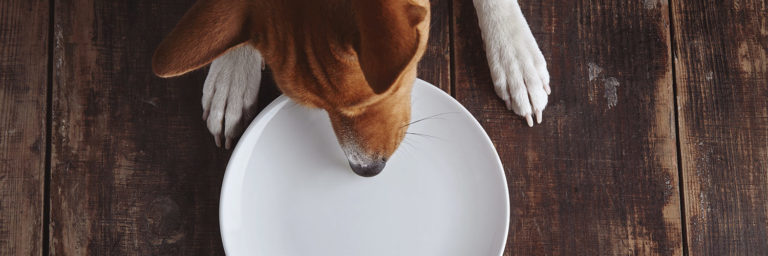The Ultimate Guide to the Best Dog Flea Treatments

Contents of Article
You don’t have to be an experienced dog owner to know that fleas are a problem. If you’ve ever dealt with them on any scale, I’m sure you’ll agree with me when I say:
Preventing a flea infestation is infinitely easier than eradicating one.
Small as they are, fleas can cause some very big problems for your dog, your home, and even your family. Fortunately, preventing a flea infestation is simple – all you need is the right flea control product.
In this guide, I’m going to teach you everything you ever wanted to know about dog fleas, including some valuable tips for what to do if you have fleas in your house. By the time you finish reading, you’ll be an expert on flea treatment for dogs and you’ll have the knowledge you need to keep your home blissfully flea-free.
Let’s get started:
What Do Fleas Look Like?
An adult flea only measures about 2.5 mm long – that’s less than the size of a black peppercorn. These tiny insects are dark in color, ranging from reddish brown to an almost black-brown. They have no wings, but they are capable of jumping a vertical distance of up to 7 inches and a horizontal distance up to 13 inches.
That may not sound like much, but think about it in comparison to the size of the flea – that’s a pretty big leap!
Dog fleas have thin, flat bodies which enables them to move quickly through your dog’s fur. They are covered in tiny hairs and they jump from one host to another using six long legs. Adult fleas have elongated mouthparts that they use to suck blood from a host animal. Flea larvae subsist primarily on “flea dirt,” or bits of undigested blood excreted by adult fleas.
How Do You Know If You Have Fleas in Your Home?
When it comes to fleas, one is like any other.
Or is it?
You may be surprised to learn that there are more than 2,000 different species of flea. The species that most commonly affects dogs is the dog flea (Ctenocephalides canis). The dog flea can technically live on a variety of different mammals but it is usually found on domestic dogs and cats.
Fleas are ectoparasites which means that they live on the outside of their host and feed on their blood. A flea can survive for months without food so, even if you haven’t had a pet in your house for some time there could still be fleas lurking about. Even more shocking is the fact that a single female flea can deliver as many as 4,000 eggs into your dog’s fur over the course of her life cycle.
So, how do you know if you have fleas in your home?
Here are some symptoms to look for:
- Your dog starts licking, scratching, or biting himself more than usual.
- You notice unusual patches of red, inflamed skin.
- Your dog starts to develop patches of hair loss or starts pulling out his own hair.
- You notice tiny black or red-brown spots in his fur or around the house.
- Your dog’s gums turn a pale shade of pink or gray.
It is important to note that an increase in scratching is not always due to fleas – there are many skin conditions and other health problems that might make your dog itchy. If you notice him scratching more than usual, however, it is definitely worth it to take a closer look and see if your dog has fleas. Use a flea comb to go through the hair at the base of your dog’s neck and tail looking for adult fleas, eggs, or flea dirt. You may also find these things on your dog’s bedding and the furniture in your house.
Once you’ve confirmed that your dog has fleas, you can start taking steps to get rid of them. Before we get into the details, however, let’s take a look at what really happens when a flea bites your dog.
Here’s what you need to know:
What Happens When a Flea Bites Your Dog?
As you already know, fleas are parasites that feed on the blood of their animal hosts. The fleas that bite your dog are the adults but, if you look closer, you’ll probably find flea eggs and larvae in your dog’s coat as well.
The entire life cycle of the flea lasts just a few weeks and it has four stages: egg, larva, pupa, and adult. The temperature in which the flea lives will impact the duration of his life cycle with higher temperatures and humidity levels speeding up the process.
When an adult flea finds its way onto your dog’s body, it will bite his skin to suck his blood. For female fleas, it is necessary for her to consume blood before she is able to produce eggs. The eggs are white in color and a little bit smaller than a grain of sand.
Eggs are usually laid in bunches of 20, though a female can deposit as many as 40 eggs per day.
After the eggs have been deposited, they’ll all off your dog’s body as he moves around so they become spread throughout the entire house. At any given time, eggs comprise about 50% of the flea population in your home – this is why treating your home for fleas is just as important as treating your dog.
The eggs develop over the course of 2 to 14 days and they hatch when the conditions are optimal. At that point, the larvae start to feed on flea dirt (the partially digested blood left by adult fleas) and they develop into pupae over the course of several weeks. In the pupae stage, the larvae spin cocoons from which they hatch into biting adult fleas. Interestingly, the pupae don’t hatch from their cocoons until certain environmental factors indicated that an animal host is nearby – things like vibrations from movement, body heat, and increased carbon dioxide levels.
Once the adult flea has hatched, it must feed from an animal host within a few hours. When a flea bites your dog, it deposits some of its saliva into the skin along with an anticoagulant chemical. This chemical helps to prevent the blood from clotting so the parasite can suck the blood more easily but it has an irritating effect on your dog’s skin.
This is where the redness and itching comes from.
Due to this irritating chemical, even a single flea bite can be harmful for your dog. The more your dog is bitten, the more compounded the negative effects will be. Some dogs even develop an allergic reaction known as flea allergy dermatitis. In puppies and smaller dogs, serious flea infestations can also cause blood loss significant enough for the dog to develop anemia.
So, how do you get rid of a flea infestation?
Keep reading to find out:
Step-by-Step Flea Removal Guide
Perhaps you’ve heard the saying that where there is one flea there are many.
Think back to what you learned in the last section – that 50% of the flea population in your home is made up of flea eggs that have been scattered around. Larvae account for about 35% of the population and pupae about 10% – that only leaves about 5% for adults!
Because a flea infestation can pervade your entire home, the removal process is neither quick nor simple. Not only do you need to rid your dog of fleas, but you also have to remove all of those eggs, larvae, and pupae so they don’t develop into adults.
Here is the order of events you should follow to get rid of fleas in your house:
- Thoroughly clean your indoor environment.
- Prevent fleas from developing in your outdoor environment.
- Kill existing fleas and prevent a repeat infestation.
Step 1: Remove Fleas from Your Home
To get rid of fleas in the house, you’ll need to do a thorough cleaning. Remember, you don’t just have to think about adults – you also need to get rid of eggs, larvae, and pupae so the infestation doesn’t recur. Here are the steps to take in cleaning your home:
- Vacuum the carpets, drapery, and upholstered furniture.
- Carefully seal the vacuum bag in a plastic bag and discard it after each use.
- Use a carpet powder, fogger, or spray to treat your home – these products will kill any remaining adults and help to prevent eggs and larvae from developing.
- Thoroughly wash your dog’s bedding and toys and treat them with a pet-safe flea control product.
- Sweep tile and hardwood areas and clean other indoor areas such as the garage, laundry room, basement, etc.
Follow the steps above continuously to prevent new infestations. You’ll want to vacuum the carpet in high-traffic areas about once a day but you might be able to get away with vacuuming less frequented areas once a week. Keep your dog’s bedding clean and follow the instructions carefully if you choose to use a fogger, spray, or carpet powder.
Step 2: Control Fleas in the Outdoor Environment
After you’ve developed a routine for keeping your home clean you can start to think about steps to take in preventing fleas from entering your home. Fleas prefer locations that are warm, moist, and shaded so look for areas of standing water or piles of organic debris in your yard. You may also want to treat your yard with a flea and tick control product, reapplying it every 7 to 14 days as directed.
If you want to go a more natural route, try treating your yard with nematodes. These are tiny, multicellular worm-like creatures that live in the soil and feed on fleas. You can find them at your local garden center or order them online.
Step 3: Treat Your Dog for Fleas
Once you’ve taken care of the existing fleas in your home, you want to tackle the source of the infestation itself – your dog.
When it comes to flea treatment for dogs, you have many options to consider. Here are the most popular control products:
- Monthly topical
- Collar
- Spray
- Shampoo
- Medication
Which option is right for your dog? Let’s explore each one in greater detail:
Monthly Topical Insecticides
This product is a topical insecticide that you apply to the skin at the base of your dog’s neck once a month. Some of the most popular options include Frontline Plus, Advantage II, and K9 Advantix. The benefit of this kind of product is that it lasts for a full 30 days and it kills fleas in all life stages. The downside is that they can be expensive and they contain chemicals that may cause side effects.
Topical applications work by depositing the active ingredient into your dog’s sweat glands so they can be spread throughout his body over the course of four weeks. These products usually start working instantly, killing existing fleas in as little as 12 hours. Most applications are waterproof and may protect against other parasites and pests like ticks and chewing lice. Topical preventives may not be safe for puppies under 8 weeks of age or those weighing less than 5 pounds.
Click to see our recommendations for topical flea and tick preventives.
Flea Collars
Another option that provides long-term protection is the flea collar. These collars are treated with chemicals similar to the ones found on topical applications and they are released slowly and continuously to provide up to 8 months of protection. Be mindful that some collars are only designed for prevention – not all of them kill existing infestations.
A flea collar is worn around the dog’s neck, delivering the strongest dose of insecticide where the fleas tend to be most highly concentrated. Some collars are effective against fleas in all life stages and many of them protect against ticks as well. Flea collars usually come in different sizes so be sure to buy the right one for your dog and pay attention to age requirements – these collars usually aren’t recommended for puppies under 7 weeks of age.
Flea Sprays
One of the most affordable options is flea spray. While some sprays are intended for short-term use only, there are some that offer protection for several months. The key is to use the product correctly. Most sprays need to be massaged into the dog’s skin and coat for maximum efficacy, so be sure to follow the instructions carefully.
Though sprays are affordable and easy to use, you do need to be cautious about getting them in your dog’s eyes or mouth. Some sprays work against all life stages and many of them help to repel mosquitos and other pests as well. If you’re looking for an option that will kill fleas fast or you want to give your dog an added layer of protection when taking him outside, a flea spray is a good option.
Flea Shampoos
This type of product is generally intended for use in conjunction with other control products. Flea shampoo is a good way to kill existing fleas in the early stages of your clean-up but you’ll need to choose another option for long-term control. You should also keep in mind that flea shampoos generally only kill adults, not eggs or larvae.
Flea Medications
If you don’t like the idea of spreading chemicals on your dog’s skin, an oral medication might be a better option. Some flea medications are only available with a veterinarian prescription, though others can be purchased over-the-counter. Be sure to know exactly what you’re buying if you choose an over-the-counter product.
Be mindful that some pills are only intended for short-term use, protecting against fleas for just 24 hours, while others provide 30 days of protection. Some pills are safe for puppies as young as 4 weeks while others have a minimum age requirement of 14 weeks or higher. Some medications kill fleas in all life stages while others primarily target adults.
A word about combination flea and tick control products:
Even if fleas are your primary concern, you should look into products that control ticks as well – both are parasites and both can cause serious problems for your dog. If you could buy a single product that protected your dog from both, why wouldn’t you do it?
By now you should have the information you need to address a flea infestation. It all starts with a thorough cleaning of your home – this includes your flooring, furniture, drapery, and especially your pet’s bedding.
Next, take steps to kill fleas outside your home to prevent your dog from bringing them inside.
Finally, choose a flea treatment for dogs to kill the fleas currently living on your dog’s body. And don’t forget to cover all of your bases with a product that is effective against all life stages from egg to adult.
Before you go, one more question to address:
What about flea medicine for puppies?
If you think back to the previous section, you may recall that most products have a minimum age requirement. So, how do you protect a puppy against fleas?
The best thing you can do is use a flea comb and a pair of tweezers to physically remove fleas from your puppy’s coat. You might also want to try a home remedy for dog fleas.
Here are some ideas:
- Herbal Flea Spray – Make a homemade spray using ½ cup lemon juice, ¼ cup witch hazel, 2 cups vinegar, and 1 cup water. Spray the mixture on carpets, furniture, drapery, floors, and pet bedding after thoroughly vacuuming and sweeping your home.
- Diatomaceous Earth – Diatomaceous earth is made up of the microscopic remains of fossilized algae and it scratches the exoskeleton of fleas and other pests, causing them to dry out and die. It is non-toxic to humans and pets, but you should be careful to purchase the food-grade type. To use it, wear a facemask and sprinkle it over your floors, carpets, and furniture.
- Apple Cider Vinegar – Create a homemade spray using one part raw, unfiltered apple cider vinegar and one part water. Spray the mixture lightly over your dog’s coat and work it into the fur and skin by hand. The fur should be damp but not wet.
- Rosemary Flea Dip – To make your own version of an herbal flea dip, steep 2 cups of fresh rosemary in boiling water for about 30 minutes. Strain the liquid and discard the rosemary then add fresh water to dilute the mixture – add up to one gallon, depending on your dog’s size. Allow the mixture to cool until lukewarm then pour it over your dog and work it into his coat. Remove the excess moisture then let his coat air dry.
There you have it! Everything you’ve ever wanted to know about dog fleas.
Now you have the knowledge you need to address a flea infestation and to eradicate it from your dog and from your home. So, don’t delay a moment longer – choose a remedy and get started!







